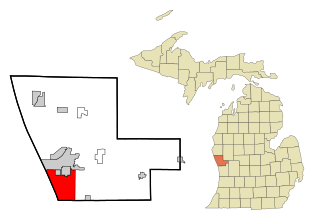
Muskegon County is a county in the U.S. state of Michigan. As of 2020, the population was 175,824. The county seat is Muskegon.

Mecosta is a village in Mecosta County in the U.S. state of Michigan. The population was 386 at the 2020 census, down from 457 in 2010. The village is within Morton Township. Mecosta Township, which is also in Mecosta County, is located several miles to the west.
Mecosta Township is a civil township of Mecosta County in Michigan. The population was 2,744 as of the 2020 census. The village of Mecosta, which is also in Mecosta County, is in Morton Township, several miles to the east.
Casnovia Township is a civil township of Muskegon County in the U.S. state of Michigan. The population was 2,793 at the 2020 census.
Dalton Township is a civil township of Muskegon County in the U.S. state of Michigan. As of the 2020 census, the township population was 9,427.
Egelston Township is a general law township of Muskegon County in the U.S. state of Michigan. As of the 2020 census, the township population was 11,128, up from 9,909 in 2010.
Fruitland Township is a civil township of Muskegon County in the U.S. state of Michigan. The population was 5,793 at the 2020 census.
Fruitport Charter Township is a charter township of Muskegon County in the U.S. state of Michigan. The population was 14,575 at the 2020 census. The village of Fruitport is within the township.
Laketon Township is a civil township of Muskegon County in the U.S. state of Michigan. The population was 7,626 at the 2020 census.
Moorland Township is a civil township of Muskegon County in the U.S. state of Michigan. The population was 1,627 at the 2020 census.
Muskegon Charter Township is a charter township of Muskegon County in the U.S. state of Michigan. The population was 17,596 at the 2020 census. The city of Muskegon borders the township to the southwest and is administratively autonomous.

Muskegon Heights is a city in Muskegon County in the U.S. state of Michigan. The population was 9,985 at the 2020 census.

Norton Shores is a city in Muskegon County in the U.S. state of Michigan. The population was 25,030 at the 2020 census.

Ravenna is a village in Muskegon County in the U.S. state of Michigan. The population was 1,308 at the 2020 census. The village is located in Ravenna Township.
Ravenna Township is a civil township of Muskegon County in the U.S. state of Michigan. As of the 2020 census, the population was 2,962, up from 2,905 in 2010. The village of Ravenna is located within the township.
Sullivan Township is a civil township of Muskegon County in the U.S. state of Michigan. As of the 2020 census, the township population was 2,541.
Whitehall Township is a civil township of Muskegon County in the U.S. state of Michigan. The population was 1,768 at the 2020 census.
Spring Lake Township is a civil township of Ottawa County in the U.S. state of Michigan. The population was 15,296 according to the 2020 census, up from 14,300 according to the 2010 census. The village of Spring Lake is located within the township.
Crockery Township is a civil township of Ottawa County in the U.S. state of Michigan. As of the 2020 census, the township population was 4,572.
Aetna Township is a civil township of Mecosta County in the U.S. state of Michigan. As of the 2020 census, the township population was 2,241.






